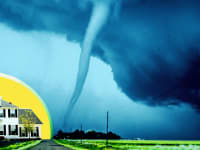Here's how to clean up your home and yard after a storm
Don't start unless you know it's safe to do so
Products are chosen independently by our editors. Purchases made through our links may earn us a commission.
Between the raging wildfires on the West Coast, damaging winds in the Midwest, and sweltering heat in the Northeast and beyond, severe weather continues to threaten life and property across the country. While many hope severe weather threats will calm down in the coming years, experts and data predict even more extreme weather is coming as climate change continues to pose a threat.
Storms and natural disasters often bring damage—fallen debris, flooded homes and electrical damage are just a few examples of what many face after disaster strikes. While preparing for a natural disaster is one thing, cleaning up the aftermath is a whole different ball game. Homeowners must proceed with the utmost caution when clearing debris from inside and outside of the home. Here’s what you need to know about safely cleaning up after a tornado hits your area.
Wait until the severe weather has completely cleared
While you may want to get a head start on cleaning up, you should hold back until weather conditions have improved—you never know if severe weather will continue to roll through after a tornado touchdown or a strong storm front.
The Centers for Disease Control (CDC) recommends staying up-to-date with local guidance via NOAA Weather Radio or TV updates. Public safety officials in your area should also be able to give you further information and instructions for what you should do next.
Understand and avoid potential dangers
Cleaning up after a natural disaster can be dangerous, based on the circumstances you’re facing. That’s why it’s best to evaluate what kind of risk you could be facing before beginning any clean-up.
A good rule of thumb is if the area looks dangerous and decrepit, don’t enter. Buildings with torn roofs, walls, or other severe damage can risk potential injury, so before any clean-up, make sure to contact your local government about what the best next steps are. You may need a professional inspector or other local authority to evaluate the safety of your home before entering.
Danger may also lurk in flooded rooms in the house. Floodwater can contain dangerous bacteria from overflowing sewage or other wastewater and can also be dangerous if it comes into contact with electrical or gas appliances.
If you're experiencing flooding in the home, be sure to turn off your home's power and gas lines before starting any clean-up if it's safe to do so. If you can't access these shut-off valves due to the floodwater, give an emergency plumbing service a call for assistance, as treading the water yourself can be risky.
In addition, immediately avoid any downed power lines that may have fallen near or on your house or yard. The CDC says you should report these electrical hazards to local police and utility companies to allow them to handle this situation.
If your home has been decimated, be sure to call local emergency services and check for any injuries to your household members. You may also need to contact your home insurance company from there before dealing with any damage.
Proceed to clean wearing the proper gear
Similar to any other disaster clean-up, it’s essential to don the proper protective equipment. Wear a hard hat, safety goggles or other eye protection, heavy-duty work gloves, and waterproof boots (with steel toe and insole preferred) to protect yourself from any debris while cleaning. The proper boots and gloves are especially important for cleaning floodwater to protect any open cuts or sores from being exposed to any potential bacteria. Be sure to also wear a long-sleeved shirt and long pants to protect your skin.
The CDC also recommends wearing an N95 mask or a respirator with a higher protection level, if possible. Of course, N95 respirator masks may still be hard to find due to the pandemic. If you have one, be sure to wear that during clean-up to avoid inhaling any potential contaminants. If not, opt for a disposable surgical mask.
Clean up the yard with caution
Before cleaning, you’ll need to evaluate the state of your trees before you begin picking up debris in the yard. Are there any snapped branches or limbs that haven’t fallen off yet? These could unexpectedly fall and injure you while you’re cleaning up the yard.
If you’re experienced with trimming your trees, you can tend to these areas using a saw with caution. Be sure to follow proper chainsaw safety protocols if you’re using one, like ensuring the tree has no contact with standing or downed power lines. If the tree is large, has many damaged and dangerous limbs, or the situation just feels unsafe to handle, opt for calling a landscaping service or storm recovery service that can handle it promptly.
If the yard is safe to clean up, begin to remove any immediate debris on the ground like loose twigs, dead plants, or leaves. Use a shovel or rake to pick up the yard waste and place it in a heavy-duty trash bag.
For miscellaneous outdoor debris, FEMA has recommended separating it into the following ‘other trash’ piles. This includes hazardous waste, household garbage, and construction debris. Proceed with caution when cleaning this up and make sure debris and trash doesn’t block the road at all.
For heavier items, the CDC recommends having at least two people work together to move and dispose of these bulky objects. You may need to call for a specific trash pickup of these filled-up trash bags, depending on what your area is offering regarding post-storm cleanup.
Your gutters may also need a major clean-up after a storm. Make sure you’ve got safety glasses and work gloves on hand and that your ladder is sturdy and reliable.
Move your clean-up efforts safely indoors
Strong storms can leave behind not-so-obvious damage to be on the lookout for. If you suspect any damage at all, the CDC says you should shut off your home’s electrical power, gas (if you have it), and propane tanks to avoid any potential fires, explosions, or electrocutions.
If your home does appear damaged, the CDC recommends staying away from the structure until a building inspector or government authority can examine it and certify that it is safe to enter.
If you're allowed to enter your home, be sure to check for other hazards, such as any frayed wiring or sparks or any sort of burning smell. If you notice this, immediately shut off the electrical system. The same goes for any suspicious gas smell—turn off the main gas valve, as this could be a sign of a gas leak. In either situation, be sure to evacuate the home right away, and do not return until you are told it's safe to do so by local authorities.
Once your house is determined to be safe for clean-up, sort debris into the proper separate piles—this may include electronics, large appliances, hazardous waste, or household garbage. Again, you may need to set up a specific trash pick-up for this kind of waste, depending on your local services.
The CDC says to be mindful of hazards like exposed nails or broken glass around the house. Your protective gear can help to keep you safe from this kind of danger. Be sure to clean up any spilled medicines, drugs, flammable liquids, or other potentially hazardous materials as you move through the house.
Practice precautions if the power goes out
If a tornado or major hurricane rolls through your area, the likelihood of a power outage is pretty high. If you need immediate light to begin clean-up, the CDC recommends the use of battery-powered lanterns rather than candles—this minimizes the risk of a house fire starting, especially when there’s extra debris like paper or wood in the home.
You may also use a generator to keep your HVAC system and appliances going, along with charging your phone in case you need to get in contact with emergency services. But, if the weather is still severe, you may need to wait it out before using a generator, as it’s dangerous to use one in rain, snow, or other wet conditions due to the risk of electrocution or possible explosion.
When it’s safe to use, be sure to keep your generator running outdoors and several feet away from the house, as exposure to carbon monoxide can lead to sudden illness or death.
More on chainsaws and power tools
- The Best Chainsaws We've Tested
- Chain-Mate manual pocket chainsaw review
- 8 Best Work Gloves and Leather Gloves
- 20 things that will save you money this summer
- Corded vs. cordless tools: Which is right for you?
- The Best Reciprocating Saws We've Tested
- Wildfire evacuation plan: How to create one and what to know
- The Best Wood Chippers We've Tested
- The Best Circular Saws We've Tested


